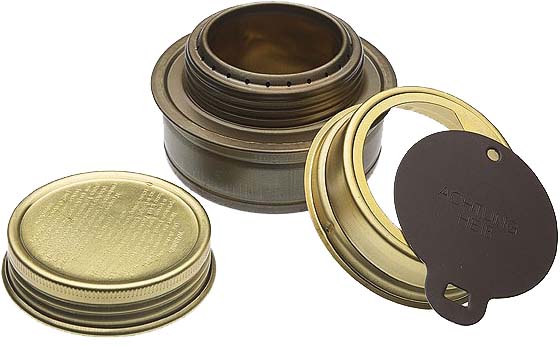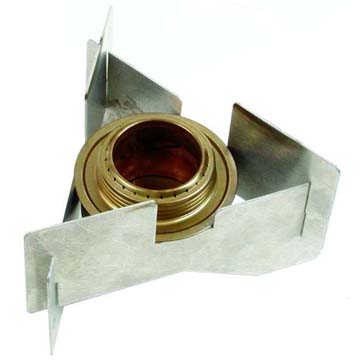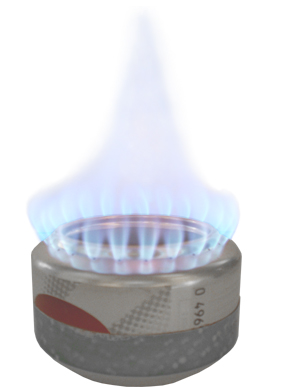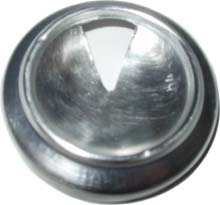|
|
|
|
Contact:
aka - The Pepsi Can Stove
Top burning alcohol stoves are generally dependable and easy to operate, just light and wait for your food or water to heat up. They also produce a circular array of individual flames similar to a gas range.

Advantages -
Works with any sized pot.
More efficient than sideburner stoves for narrow pots as you have better flame contact with the bottom of the stove.
Easiest to light - self primes.
Many simmer options.
Works.
Easy to find parts.
Can light without primer pan.
Drawbacks -
Requires a pot stand.
Perhaps less efficient than other designs because of large open center.

6.6oz Trangia with Westwind Stand
The Swedish Trangia stove has been around for over fifty years. This dependable stove has been popular with both European military and civilian outdoorsman. Made of brass, it has a wide open chamber for adding fuel, jets around the top rim and a wick in its outer chamber to soak up liquid fuel.

Topburner Open Jet Stove
One of the most popular styles of homemade alcohol stoves around is based on Scott Henderson's Pepsi Stove (Web Archive). Acceptable fuels include denatured alcohol (ethanol), HEET (methanol) and others (see Fuel Options). It requires a pot stand or rocks to hold the pot about 1-1.5inches from the top of stove.
The stove shown above is made from two 12oz pop can bottoms. Twenty-four jets were drilled around the outer base of the circular ridge on top of the stove, with a #71 drill (about needle size). The bottom section of stove is 20mm tall. The top piece is about 30mm tall and the inner cylinder is 40mm wide.
Simmering is fairly easy to do and you have many options, such as placing a cutout 12oz pop can bottom with a hole cut in it (or something similar - like a piece of foil) on top of the stove.

Simmer attachment
Note - This is just one of the many DIY alcohol stove options. For more information on different options visit Zen and the Art of the Alcohol Stove and the Templates page.
Construction

Start by scoring a circular line around the inside rim on the bottom of an empty can (as shown above). Go around and around a couple of times until it's well scored.

If you are good with your hands and a hobby knife, you can cheat and poke a tiny starter hole. If you aren't good with your hands and a hobby knife, this technique will lead to damaging your can or a self inflicted flesh wound.

Press the back of a knife handle into your scored line to start a tear.

Pop out the top and beware or the razor sharp ragged edge in your can. An SOS pad can be used to smooth out any dangerous edges.

Use a sewing pin (shown - a pin designed for holding fabric together and not a pin designed for use as a thumb tack) or #8 Sewing needle in an electric drill to drill out 24 evenly spaced jets around the ridge of your 30mm tall can section.
A template taped to the top of your can section may be used to help you evenly space jets.
Alternately you can use a #80 drill for a guide hole followed by a #74 drill for cleaner jets.
Note: Wear eye protection when using a drill in this manner as these small pins and machine drills can shatter while drilling.

Mark a circumferential line 30mm from the bottom of the can you are working on and 20mm from the bottom of a second empty can.

Use scissors and trim down to your circumferential marks.
Polishing the edges with an SOS pad will aid in assembly and decrease the chance of skin lacerations later on.

Print out a 40mm inner wall template and tape it to a section from the side of a 12oz beverage can.

Use a hole punch to punch out the three bottom weep holes.

Cut your side slits, trim your inner wall, and lock the slits together to form a cylinder as shown above.
↓ ↓
↓
Press a Dilator Tool into your 20mm bottom section. This should enlarge your 20mm section so that it can slip over your 30mmm section.
Perform a test fit to ensure the 20mm section slide fit over the 30mm section. If it doesn't, repeat using the Dilator Tool until it does.
Note: an unopened can of the same size as your section to be stretched can be used in lieu of a Dilator Tool, but you may need to really work it by repeatedly pressing it into the bottom section at less than perpendicular angles. You are more likely to buckle the sidewall of the top section during assembly if you choose to just use an unaltered unopened can.

Smear some high temperature RTV silicone or JB Weld on the inner wall of your 20mm section.

Set your inner wall in your 20mm section.

Carefully fit your 30mm section into your 20mm section.
You may need to use a shim (shown above) to get it to fit. Just take your time to avoid damaging your stove.
To make a shim, cut out a section of aluminum from a beverage can, round off edges with scissors and polish these edges smooth with an SOS pad and/or metal polish. Smooth edges are important if you wish to avoid damaging your can sections.

Press it all together, set a heavy book on it and let the silicone vulcanize overnight before testing your stove.